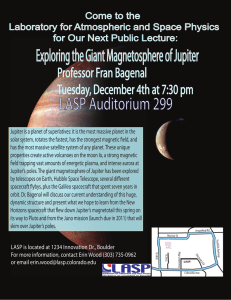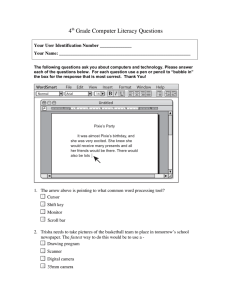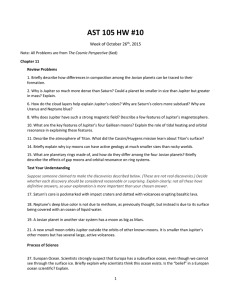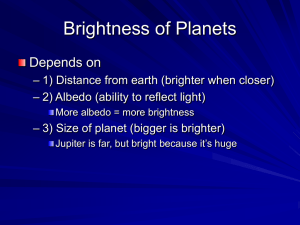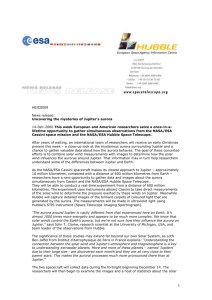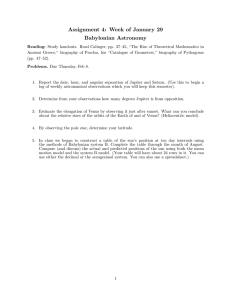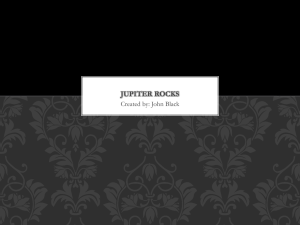Cassini//Huygens flyby of the Jovian system Jean-Pierre Lebreton
advertisement
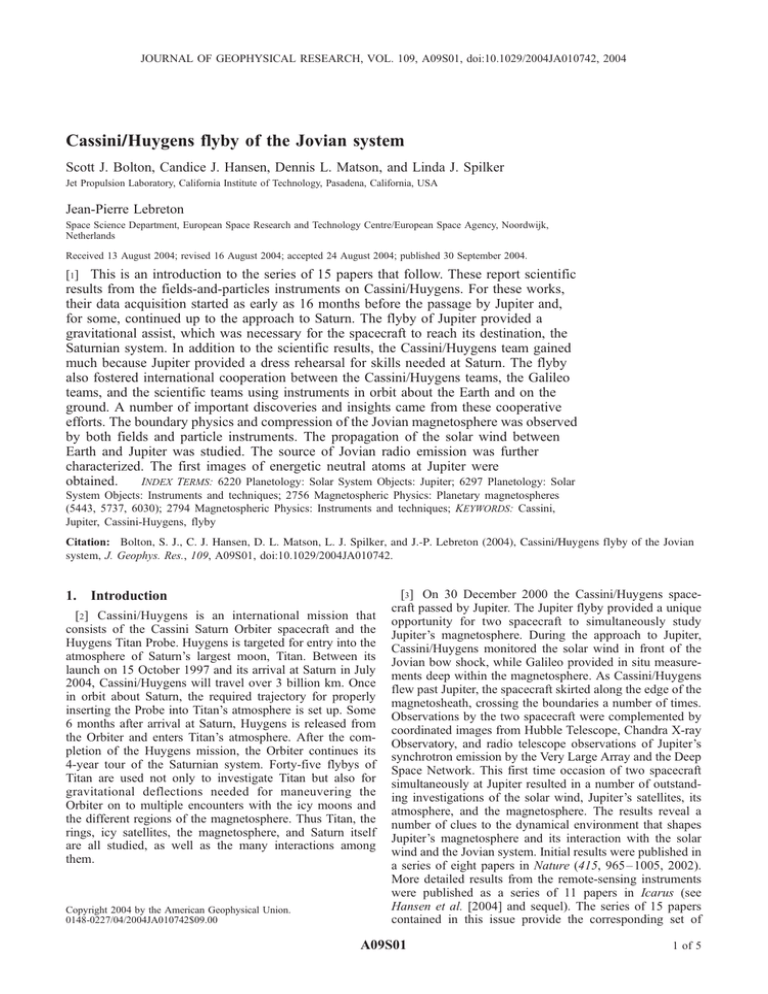
JOURNAL OF GEOPHYSICAL RESEARCH, VOL. 109, A09S01, doi:10.1029/2004JA010742, 2004 Cassini//Huygens flyby of the Jovian system Scott J. Bolton, Candice J. Hansen, Dennis L. Matson, and Linda J. Spilker Jet Propulsion Laboratory, California Institute of Technology, Pasadena, California, USA Jean-Pierre Lebreton Space Science Department, European Space Research and Technology Centre/European Space Agency, Noordwijk, Netherlands Received 13 August 2004; revised 16 August 2004; accepted 24 August 2004; published 30 September 2004. [1] This is an introduction to the series of 15 papers that follow. These report scientific results from the fields-and-particles instruments on Cassini/Huygens. For these works, their data acquisition started as early as 16 months before the passage by Jupiter and, for some, continued up to the approach to Saturn. The flyby of Jupiter provided a gravitational assist, which was necessary for the spacecraft to reach its destination, the Saturnian system. In addition to the scientific results, the Cassini/Huygens team gained much because Jupiter provided a dress rehearsal for skills needed at Saturn. The flyby also fostered international cooperation between the Cassini/Huygens teams, the Galileo teams, and the scientific teams using instruments in orbit about the Earth and on the ground. A number of important discoveries and insights came from these cooperative efforts. The boundary physics and compression of the Jovian magnetosphere was observed by both fields and particle instruments. The propagation of the solar wind between Earth and Jupiter was studied. The source of Jovian radio emission was further characterized. The first images of energetic neutral atoms at Jupiter were INDEX TERMS: 6220 Planetology: Solar System Objects: Jupiter; 6297 Planetology: Solar obtained. System Objects: Instruments and techniques; 2756 Magnetospheric Physics: Planetary magnetospheres (5443, 5737, 6030); 2794 Magnetospheric Physics: Instruments and techniques; KEYWORDS: Cassini, Jupiter, Cassini-Huygens, flyby Citation: Bolton, S. J., C. J. Hansen, D. L. Matson, L. J. Spilker, and J.-P. Lebreton (2004), Cassini/Huygens flyby of the Jovian system, J. Geophys. Res., 109, A09S01, doi:10.1029/2004JA010742. 1. Introduction [2] Cassini/Huygens is an international mission that consists of the Cassini Saturn Orbiter spacecraft and the Huygens Titan Probe. Huygens is targeted for entry into the atmosphere of Saturn’s largest moon, Titan. Between its launch on 15 October 1997 and its arrival at Saturn in July 2004, Cassini/Huygens will travel over 3 billion km. Once in orbit about Saturn, the required trajectory for properly inserting the Probe into Titan’s atmosphere is set up. Some 6 months after arrival at Saturn, Huygens is released from the Orbiter and enters Titan’s atmosphere. After the completion of the Huygens mission, the Orbiter continues its 4-year tour of the Saturnian system. Forty-five flybys of Titan are used not only to investigate Titan but also for gravitational deflections needed for maneuvering the Orbiter on to multiple encounters with the icy moons and the different regions of the magnetosphere. Thus Titan, the rings, icy satellites, the magnetosphere, and Saturn itself are all studied, as well as the many interactions among them. Copyright 2004 by the American Geophysical Union. 0148-0227/04/2004JA010742$09.00 [3] On 30 December 2000 the Cassini/Huygens spacecraft passed by Jupiter. The Jupiter flyby provided a unique opportunity for two spacecraft to simultaneously study Jupiter’s magnetosphere. During the approach to Jupiter, Cassini/Huygens monitored the solar wind in front of the Jovian bow shock, while Galileo provided in situ measurements deep within the magnetosphere. As Cassini/Huygens flew past Jupiter, the spacecraft skirted along the edge of the magnetosheath, crossing the boundaries a number of times. Observations by the two spacecraft were complemented by coordinated images from Hubble Telescope, Chandra X-ray Observatory, and radio telescope observations of Jupiter’s synchrotron emission by the Very Large Array and the Deep Space Network. This first time occasion of two spacecraft simultaneously at Jupiter resulted in a number of outstanding investigations of the solar wind, Jupiter’s satellites, its atmosphere, and the magnetosphere. The results reveal a number of clues to the dynamical environment that shapes Jupiter’s magnetosphere and its interaction with the solar wind and the Jovian system. Initial results were published in a series of eight papers in Nature (415, 965– 1005, 2002). More detailed results from the remote-sensing instruments were published as a series of 11 papers in Icarus (see Hansen et al. [2004] and sequel). The series of 15 papers contained in this issue provide the corresponding set of A09S01 1 of 5 A09S01 BOLTON ET AL.: INTRODUCTION A09S01 Figure 1. Cassini was launched in October 1997 on a trajectory that arrived at Saturn in 2004. En route, Venus, Earth, and Jupiter provided ‘‘gravity assists.’’ The Jovian flyby let us exercise the spacecraft, the instruments, and all the Cassini teams in a ‘‘dress rehearsal’’ for the coming work at Saturn. The Jupiter flyby also yielded new scientific results for the Jovian system. These are presented in this special section. See color version of this figure in the HTML. detailed results from the fields-and-particles instruments and concludes the overall series of papers on results from the Cassini-Huygens flyby of Jupiter. 2. Spacecraft and Payload Overview [4] On the launch pad, the mass of the fully fuelled spacecraft weighed 5636 kg. Cassini consists of several sections. Starting at the bottom of the ‘‘stack’’ and moving upward, these are the lower equipment module, the propellant tanks together with the engines, the upper equipment module, the 12-bay electronics compartment, and the highgain antenna (HGA) which has a diameter of 4 m. These are all stacked vertically on top of each other. Attached to the side of the stack is the approximately 3-m diameter, diskshaped Huygens Probe. Cassini/Huygens accommodates some 27 different scientific investigations that are supported by 18 specially designed instruments, 12 on the Orbiter and six on the Probe. Most of the Orbiter’s scientific instruments are installed on one of two body-fixed platforms. These are called the remote-sensing pallet and the particles-and-fields pallet. An 11-m-long boom supports sensors for the dual technique Magnetometer (MAG) experiment. Three skinny 10-m-long electrical antennae point in three orthogonal directions. These are sensors for the Radio and Plasma Wave Science (RPWS) experiment. The Orbiter carries the Magnetospheric Imaging Instrument (MIMI) to provide measurements of energetic particles and the Cassini Plasma Spectrometer (CAPS) to provide measurements of the plasma. Figure 3 shows the energy range capabilities of CAPS and MIMI. [5] Two-way communication with Cassini is via the Deep Space Network (DSN) with an X-band radio link, which uses either the 4-m-diameter high-gain antenna (HGA) or one of the low gain antennae. The high-gain antenna is also used for radio and radar experiments and for receiving signals from Huygens. At Saturn, communications will be via the HGA. Additional information on the spacecraft is available in the literature. For example, see Burton et al. [2001], Matson et al. [2002], and Spilker [1997]. 3. Mission Overview [6] Paradoxically, Cassini/Huygens did not immediately head for the outer solar system but went inward toward Venus to pick up additional gravitational assistance because even the great thrust of the Titan-Centaur was insufficient to propel the massive spacecraft on its way to Saturn. Two Venus swingbys would be necessary, followed by an Earth gravity assist plus one at Jupiter before the spacecraft had sufficient energy to climb far enough out of the Sun’s gravitational potential well to reach Saturn. [7] The second swingby of Venus occurred at an altitude of 598 km on 24 June 1999. This provided a unique opportunity for the fields and particles instruments to study the interaction of the solar wind with Venus, a planet with no intrinsic magnetic field. Cassini/Huygens has a much more capable fields-and-particles payload than previous Venus missions. This was followed 3 months later by a swingby of the Earth. The results of these encounters are published in a series of 11 papers (Burton et al. [2001] and sequel). 2 of 5 A09S01 BOLTON ET AL.: INTRODUCTION A09S01 [8] The primary purpose of the flyby of Jupiter was to provide the gravitational deflection necessary to send Cassini-Huygens to Saturn, arriving in July 2004. The Jupiter flyby also provided an opportunity to obtain important calibration data for the experiments and essentially carry out a dress rehearsal for science operations at Saturn. The spacecraft flew to within a range of 9,800,000 km or 138 Jovian radii of Jupiter on 30 December 2000. [9] Observations of Jupiter and the solar wind began earlier, providing an extended monitoring of the solar wind conditions near 5 AU. Figure 1 depicts the Cassini-Huygens trajectory from launch in October 1997 though Saturn arrival in 2004. The opportunity for a two-spacecraft experiment was afforded by the fact that the Galileo spacecraft, in orbit around Jupiter since December 1995, continued to be in operational good health. Figure 2 shows both the Cassini-Huygens trajectory and the Galileo orbits for a period from approximately 60 days prior to CassiniHuygens Jupiter closest approach along with model predictions for the location of the bow shock based on Voyager measurements. The trajectories of Voyager 1 and 2 are also shown for reference. Unlike the Galileo dual spin spacecraft design, Cassini/Huygens is a three-axis stabilized spacecraft without a scan platform; thus the entire spacecraft must be turned to point the instruments. This is important to the Figure 3. The energy ranges for the Cassini fields-andparticles instruments. The horizontal axis is energy in eV. The coverage is comprehensive, as is required for a mission with a broad range of scientific objectives. interpretation of fields-and particles-data, as full threedimensional distributions of the plasma and energetic particles is not usually available and quality of science observations are occasionally limited by the sharing of pointing between competing science objectives (see Hansen et al. [2004] and Matson et al. [2002] for further discussion of these points). Figure 2. The Cassini Jovian flyby trajectory is compared with the paths of the Galileo and Voyager spacecraft. The trajectories are projected on the ecliptic plane. The sun is in the +X direction, off the top of the figure. Cassini’s slow flyby enabled a 6-month study of the dynamics of the atmosphere of Jupiter and Io’s torus. During the approach the Cassini spacecraft was out in the solar wind in front of the bowshock of Jupiter’s magnetosphere, while Galileo was in Jupiter’s magnetosphere. As the Cassini spacecraft flew on past Jupiter, the spacecraft skirted along the edge of the magnetosheath. The boundary crossed over the spacecraft a number of times as it left Jupiter’s environs. See color version of this figure in the HTML. 4. Science Observations [10] Early results from the flyby of Jupiter demonstrated the value of having two spacecraft at Jupiter and are discussed in a series of eight papers in Nature (Hill [2002] and sequel). Kurth et al. [2002] report multiple boundary crossings and evidence for a well-developed boundary layer just inside of the magnetopause. Gurnett et al. [2002] suggest that three shocks were responsible for triggering increases in radio and auroral emissions, and Krimigis et al. [2002] report on the first observations of a hot and fast magnetospheric neutral wind extending away from Jupiter. The flyby also offered an opportunity to map Jupiter’s synchrotron emission at high frequency, providing 3 of 5 A09S01 BOLTON ET AL.: INTRODUCTION insights into the ultrarelativistic electron populations trapped in Jupiter’s inner radiation belts [Bolton et al., 2002]. Additional results discussing details of the CassiniHuygens remote sensing observations at Jupiter and its satellites appear in Icarus (Hansen et al. [2004] and 10paper sequel). In this paper we present an introduction and overview of the 15 papers contained in this issue which describe the Cassini measurements of the solar wind and Jupiter’s magnetosphere and comparison to measurements made by near-Earth satellites, Ulysses, and at Jupiter by Galileo. 4.1. Solar Wind Observations [11] Comparisons between Cassini-Huygens solar wind measurements at 5 –8 AU and near-Earth spacecraft provided an opportunity to study structure evolution between 1 AU and the outer solar system. Lario et al. [2004] and Hanlon et al. [2004a] present fields and particles measurements from the solar maximum of cycle 23. Effects of transient structures on the propagation of particles are evident in the measurements of energetic particles and plasma as well as the magnetic field. 4.2. Multiple Spacecraft Magnetospheric Observations [12] Dual spacecraft measurements of Jupiter’s radio emission revealed important results on the source and propagation of magnetospheric radio emission. On the basis of simultaneous measurements by Galileo and CassiniHuygens, Hospodarsky et al. [2004] suggest the nature of Jovian quasi-periodic (QP) bursts is more strobe-like (pulsed) as opposed to a rotating searchlight. Using measurements from Ulysses and Cassini-Huygens, Kaiser et al. [2004] report a similar finding for the Very Low Frequency (VLF) radio emission at Jupiter. Both studies state the observations rule out a source that corotates with the planet, suggesting the emission is modified by interaction with the magnetosheath. These observations have important implications for the study of Jupiter radio emissions, as well as potentially affecting our understanding of similar phenomena at Earth. Dual spacecraft observations in and out of the magnetosphere also provide new insights on the signature of compression events [Hanlon et al., 2004b]. 4.3. Results From Cassini-Huygens Observations of Jupiter’s Magnetosphere [13] Results from electron measurements near Jupiter’s magnetopause are reported by Svenes et al. [2004], providing a characterization of the magnetopause boundary effectively acting as a hard boundary to low-energy plasma. Achilleos et al. [2004] discuss details of the Cassini measured magnetic signatures of bow shock crossings and compare the observations to a Voyager and Pioneer based model. They conclude that the global shape of the Jovian bow shock and intrinsic compressibility of the magnetosphere is stable over long periods of time. The Cassini-Huygens trajectory fortuitously skirted along the magnetospheric boundary for an extended period, allowing for an in-depth study of the physics associated with the magnetosheath, magnetopause, and bow shock. Krupp et al. [2004] report on energetic particle pitch angle distribution and flux level variations associated with the cross- A09S01 ings of these boundaries. The data indicate surprising structure in the dynamics at distances out to 400 RJ, suggesting Cassini-Huygens may have passed through a dusk-midnight magnetosheath region where Jupiter feeds energetic electrons to the heliosphere. Mitchell et al. [2004] report on the first-ever energetic neutral atom (ENA) images of Jupiter’s magnetosphere. The measurements show the emission is dominated by hydrogen atoms associated with the neutral gas in Jupiter’s exosphere and to a lesser extent by heavier atoms (i.e., sulfur and oxygen) from the Io torus. Mauk et al. [2004] use in situ energetic ion measurements from Galileo to aid in the interpretation of Cassini ENA observations. Among other significant findings, they suggest that plasma pressure from energetic sulfur ions is important in supporting the magnetodisk against the magnetic pressure from the lobe regions at distances planetward of 46 RJ. Recent Hubble Space Telescope observations of Jovian aurora revealed new features poleward of the main oval suggested to be related to a Jovian cusp. Bunce et al. [2004] report on analysis investigating slow and fast flow models corresponding to varying values of the interplanetary magnetic field. Using high-resolution observations of the broadband kilometric radiation, Farrell et al. [2004] suggest the emission characteristics are consistent with a source of plasma density bubbles affected by an interchange instability. 4.4. Instrument Calibrations [14] The Jupiter flyby also offered unique opportunities to obtain instrument calibration data useful for interpretation of observations at Saturn. Zarka et al. [2004] and Vogl et al. [2004] describe two examples of calibration of the Radio and Plasma Wave Subsystem experiment. [15] Acknowledgments. A portion of this work was carried out at the Jet Propulsion Laboratory, California Institute of Technology, under a contract with the National Aeronautics and Space Administration. [16] This paper was reviewed by editor Arthur Richmond. References Achilleos, N., M. K. Dougherty, D. T. Young, and F. Crary (2004), Magnetic signatures of Jupiter’s bow shock during the Cassini flyby, J. Geophys. Res., doi:10.1029/2003JA010258, in press. Bolton, S. J., et al. (2002), Ultra-relativistic electrons in Jupiter’s radiation belts, Nature, 415, 987 – 991, doi:10.1038/415987a. Bunce, E. J., S. W. H. Cowley, and T. K. Yeoman (2004), Jovian cusp processes: Implications for the polar aurora, J. Geophys. Res., doi:10.1029/2003JA010280, in press. Burton, M. E., B. Buratti, D. L. Matson, and J.-P. Lebreton (2001), The Cassini/Huygens Venus and Earth flybys: An overview of operations and results, J. Geophys. Res., 106, 30,099 – 30,108. Farrell, W. M., M. L. Kaiser, W. S. Kurth, M. D. Desch, D. A. Gurnett, G. B. Hospadarsky, and R. J. MacDowall (2004), Remote sensing of possible plasma density bubbles in the inner Jovian dayside magnetosphere, J. Geophys. Res., doi:10.1029/2003JA010130, in press. Gurnett, D. A., et al. (2002), Control of Jupiter’s radio emission and aurorae by the solar wind, Nature, 415, 985 – 987, doi:10.1038/415985a. Hanlon, P. G., M. K. Dougherty, R. J. Forsyth, M. J. Owens, K. C. Hansen, G. Tóth, F. J. Crary, and D. T. Young (2004a), On the evolution of the solar wind between 1 and 5 AU at the time of the Cassini Jupiter flyby: Multispacecraft observations of interplanetary coronal mass ejections including the formation of a merged interaction region, J. Geophys. Res., doi:10.1029/2003JA010112, in press. Hanlon, P., M. K. Dougherty, N. Krupp, K. C. Hansen, F. J. Crary, D. T. Young, and G. Toth (2004b), Dual spacecraft observations of a compression event within the Jovian magnetosphere: Signatures of externally triggered supercorotation?, J. Geophys. Res., doi:10.1029/ 2003JA010116, in press. 4 of 5 A09S01 BOLTON ET AL.: INTRODUCTION Hansen, C. J., S. J. Bolton, D. L. Matson, and L. J. Spilker (2004), The Cassini Flyby of Jupiter, Icarus, in press. Hill, T. (2002), Planetary science: Magnetic moments at Jupiter, Nature, 415, 965 – 966, doi:10.1038/415965a. Hospodarsky, G. B., W. S. Kurth, B. Cecconi, D. A. Gurnett, M. L. Kaiser, M. D. Desch, and P. Zarka (2004), Simultaneous observations of Jovian quasi-periodic radio emissions by the Galileo and Cassini spacecraft, J. Geophys. Res., doi:10.1029/2003JA010263, in press. Kaiser, M. L., W. M. Farrell, W. S. Kurth, G. B. Hospodarsky, and D. A. Gurnett (2004), New observations from Cassini and Ulysses of Jovian VLF radio emissions, J. Geophys. Res., doi:10.1029/2003JA010233, in press. Krimigis, S. M., et al. (2002), A nebula of gases from Io surrounding Jupiter, Nature, 415, 994 – 997, doi:10.1038/415994a. Krupp, N., et al. (2004), Energetic particle observations in the vicinity of Jupiter: Cassini MIMI/LEMMS results, J. Geophys. Res., doi:10.1029/ 2003JA010111, in press. Kurth, W. S., et al. (2002), The dusk flank of Jupiter’s magnetosphere, Nature, 415, 991 – 994, doi:10.1038/415991a. Lario, D., S. Livi, E. C. Roelof, R. B. Decker, S. M. Krimigis, and M. K. Dougherty (2004), Heliospheric energetic particle observations by the Cassini spacecraft: Correlation with 1 AU observations, J. Geophys. Res., doi:10.1029/2003JA010107, in press. Matson, D. L., L. J. Spilker, and J.-P. Lebreton (2002), The CassiniHuygens mission to the Saturnian system, Space Sci. Rev., 104, 1 – 58. Mauk, B. H., D. G. Mitchell, R. W. McEntire, C. P. Paranicas, E. C. Roelof, D. J. Williams, S. M. Krimigis, and A. Lagg (2004), Energetic ion characteristics and neutral gas interactions in Jupiter’s magnetosphere, J. Geophys. Res., 109, A09S12, doi:10.1029/2003JA010270. A09S01 Mitchell, D. G., C. P. Paranicas, B. H. Mauk, E. C. Roelof, and S. M. Krimigis (2004), Energetic neutral atoms from Jupiter measured with the Cassini magnetospheric imaging instrument: Time dependence and composition, J. Geophys. Res., 109, A09S11, doi:10.1029/ 2003JA010120. Spilker, L. J. (Ed.) (1997), Passage to a ringed world: The Cassini- Huygens mission to Saturn and Titan, NASA SP-533, 157 pp., NASA, Washington, D. C. Svenes, K. R., B. T. Narheim, A. J. Coates, D. R. Linder, and D. T. Young (2004), Cassini Plasma Spectrometer electron measurements close to the magnetopause of Jupiter, J. Geophys. Res., doi:10.1029/2003JA010254, in press. Vogl, D. F., et al. (2004), In-flight calibration of the Cassini-RPWS antenna system for direction-finding and polarization measurements, J. Geophys. Res., doi:10.1029/2003JA010261, in press. Zarka, P., B. Cecconi, and W. S. Kurth (2004), Jupiter’s low-frequency radio spectrum from Cassini/Radio and Plasma Wave Science (RPWS) absolute flux density measurements, J. Geophys. Res., doi:10.1029/ 2003JA010260, in press. S. J. Bolton, C. J. Hansen, D. L. Matson, and L. J. Spilker, Jet Propulsion Laboratory, California Institute of Technology, Pasadena, CA, USA. (scott.j.bolton@jpl.nasa.gov) J.-P. Lebreton, Space Science Department, European Space Research and Technology Centre/European Space Agency, Noordwijk, Netherlands. 5 of 5
